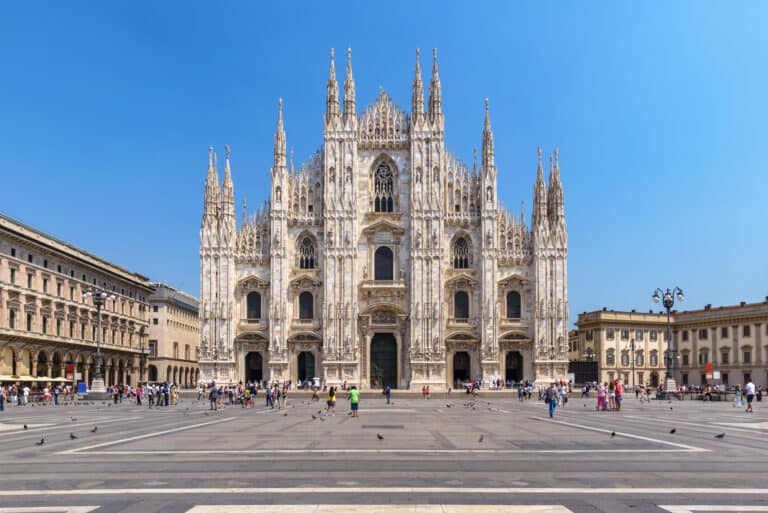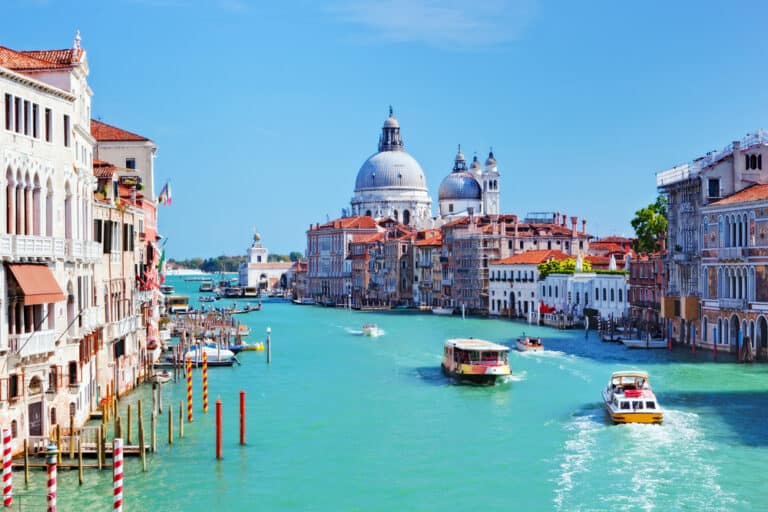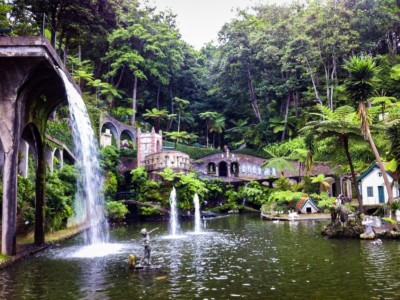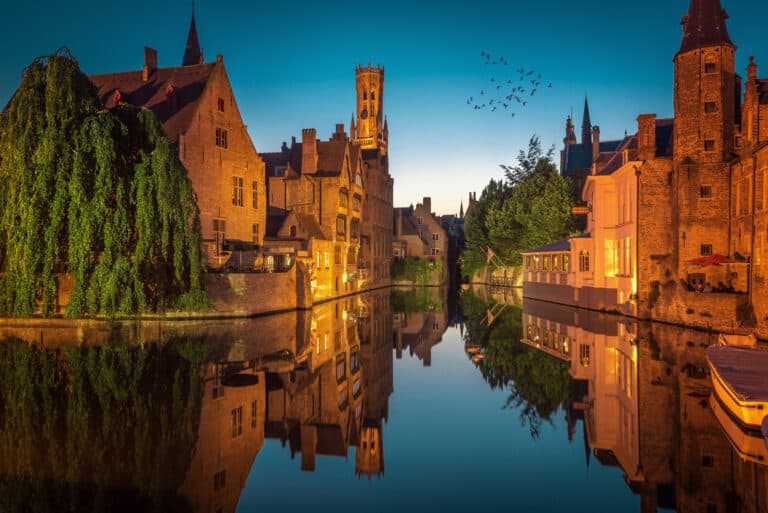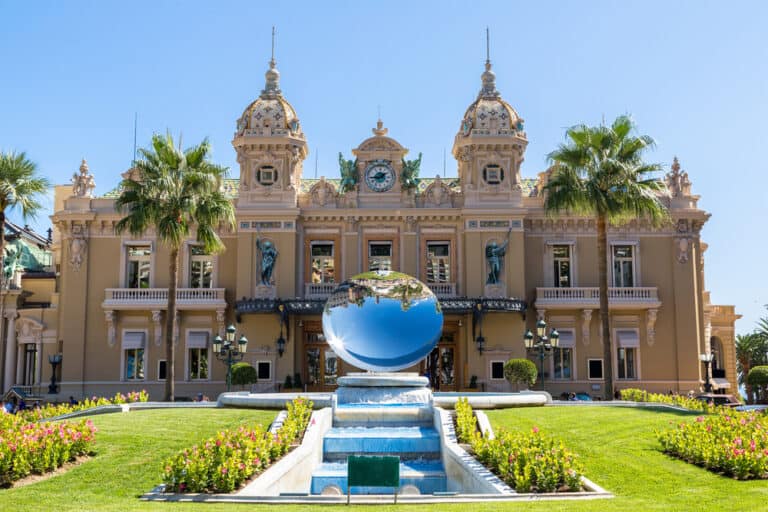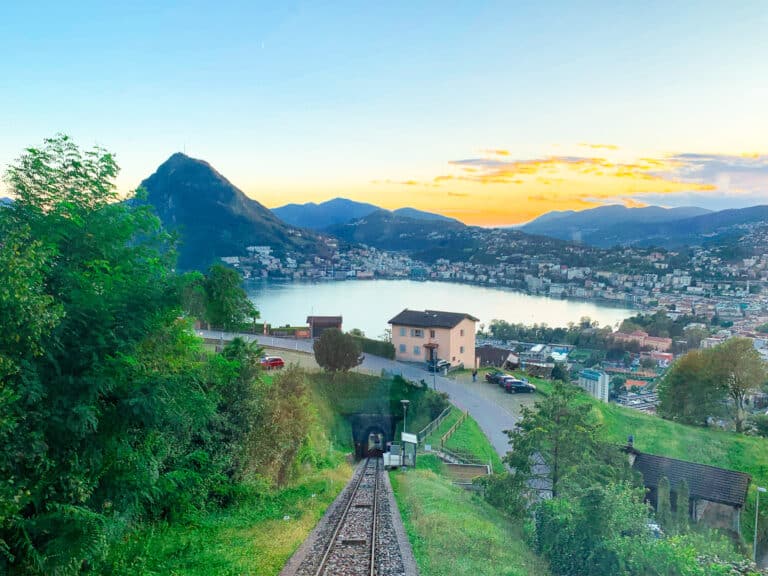A weekend in Bruges: the top things to put on your itinerary
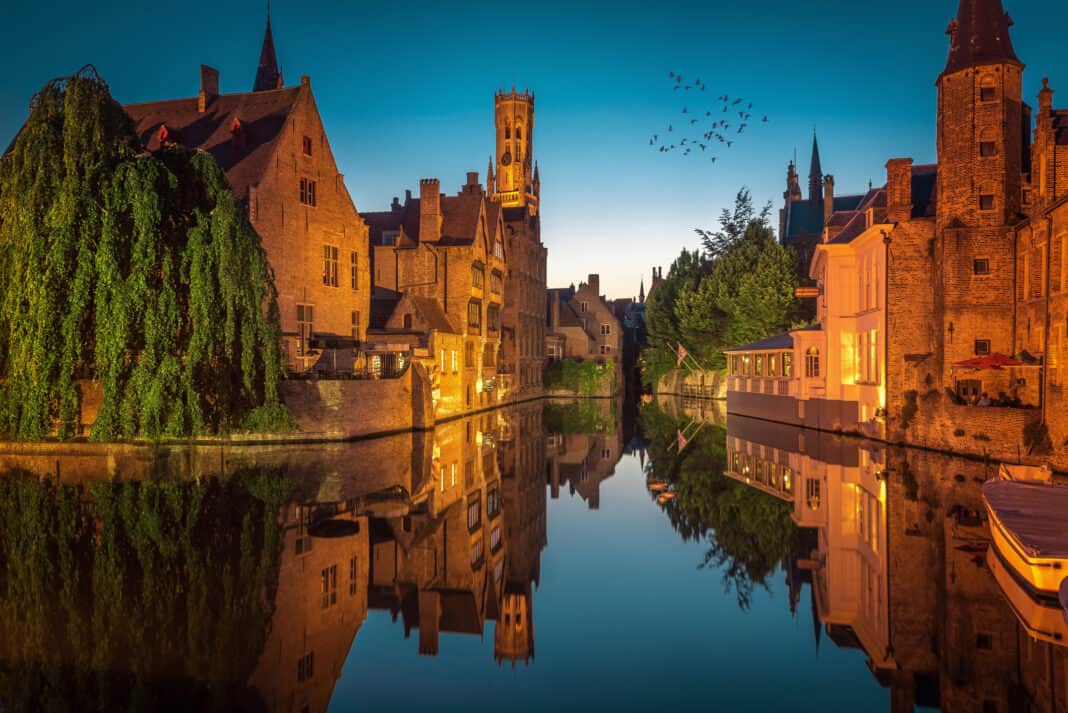
Bruges is one of the most popular destinations in Belgium. When you visit, it’s not hard to see why and why many people choose to spend a weekend in Bruges.
Millions every year are drawn to Bruges’ picturesque vistas of historic landmarks, cobbled streets, beautiful medieval buildings, and scenic canals. The city’s historic centre has been designated a UNESCO World Heritage Site thanks to this outstanding collection.
As you will discover, there are plenty of things to see on a weekend in Bruges. Below are the top things to put on your itinerary, plus information to help you plan your trip.
This post contains affiliate links
A weekend in Bruges: the top things to put on your itinerary
If you’re planning a weekend in Bruges, here are the top things to do.
A weekend in Bruges
– Wander around the Grote Markt
– Climb the Belfry of Bruges
– Learn about the history of the city in the Historium Bruges
– See the impressive buildings in Burg Square
– Go to Rosary Quay, one of the most photographed spots in Bruges
– See the city on a canal boat cruise or from a horse-drawn carriage
– Stroll up to Dijver and see some art in the nearby museums
– Go to the Church of Our Lady
– See the popular Boniface Bridge
– Head up to the Begijnhof
– See the Lake of Love and walk across Lovers’ Bridge
– Try some Belgian beer and chocolate
– Wander up to one of the city’s old windmills
– Day trip to Brussels
Read on for more information on these sights and experiences, and for practical information to help you plan your weekend in Bruges.
About Bruges
Location
The Belgian city of Bruges is located in the north of the country in the Flemish-speaking Flanders region.
Situated a short distance from the North Sea coast, Bruges has a longstanding relationship with the sea and international trade. In fact, the coastal city of Ostend is less than 15 minutes away by train.
Only an hour’s train journey from Brussels, it’s possible to day trip to the capital from here. Bruges also has superb rail connections to other notable Belgian destinations.
This includes Ghent, which is located roughly at the halfway point between Brussels and Bruges (fast trains take less than half an hour). Both Leuven and Mechelen connect to Bruges by train in under two hours.
Given that rail travel is reasonably cheap in Belgium and it’s a relatively small country, this means you could also easily build a visit to Bruges into a wider trip.
Architecture
Unlike some Belgian cities, Bruges was spared the devastation of World War II. Even outside the central attractions, you will discover grand historic buildings that will remind you that Bruges’ architecture has changed little since the Middle Ages.
Unlike nearby Ghent, which has undergone some post-war reconstruction in parts, Bruges has successfully limited its modern developments, lending the city a real ‘chocolate box’ feel.
Although it’s a bit of a cliché to call it the ‘Venice of the North’, as some commentators do (and Amsterdam would probably have something to say about that!), it’s certainly the case that its network of canals does make it striking.

How to get to Bruges
Regardless of where you are coming from and what mode of transport you plan to use, Bruges is really easy to get to.
If you are not planning to visit on a coach tour or are travelling to the city by car, the most common route is via train from Brussels.
Many UK-based tourists visit Bruges by taking the Eurostar train from London St Pancras, changing trains (and platforms) at Brussels’ Gare Du Midi (Bruxelles Midi). From here it is about an hour’s train journey to Bruges. To give you an idea of cost, a single train ticket from Gare Du Midi to Bruges train station cost 16 euros in October 2023.
However, most tourists will probably arrive at Brussels International Airport. This does have some direct trains to Bruges via central Brussels. Expect a journey time of one hour and 30 minutes.
Getting from Bruges train station into the city centre
When you arrive at Bruges train station, you’ll find a huge outdoor hub for buses where you can pick up a number of different buses into the city centre. You can pay with your contactless bank card on the bus (as of October 2023, this only cost 2.50 euros).
This is probably your best bet if you have lots of luggage, the weather is poor, or it is dark.
However, if you arrive during the day, the sun is out, and you are happy to carry your luggage for the 20-25 minute walk into the historic centre, there is no better introduction to Bruges.
After you’ve picked up a city map from the tourist information centre at the station exit, just cross over the main road and follow the crowds. There are several walking routes into the centre, but the most scenic is via Begijnenvest and Minnewater (Lovers’ Lake).
If you are worried about getting lost, just remember to head in the direction of the Church of Our Lady’s unmissable spire.
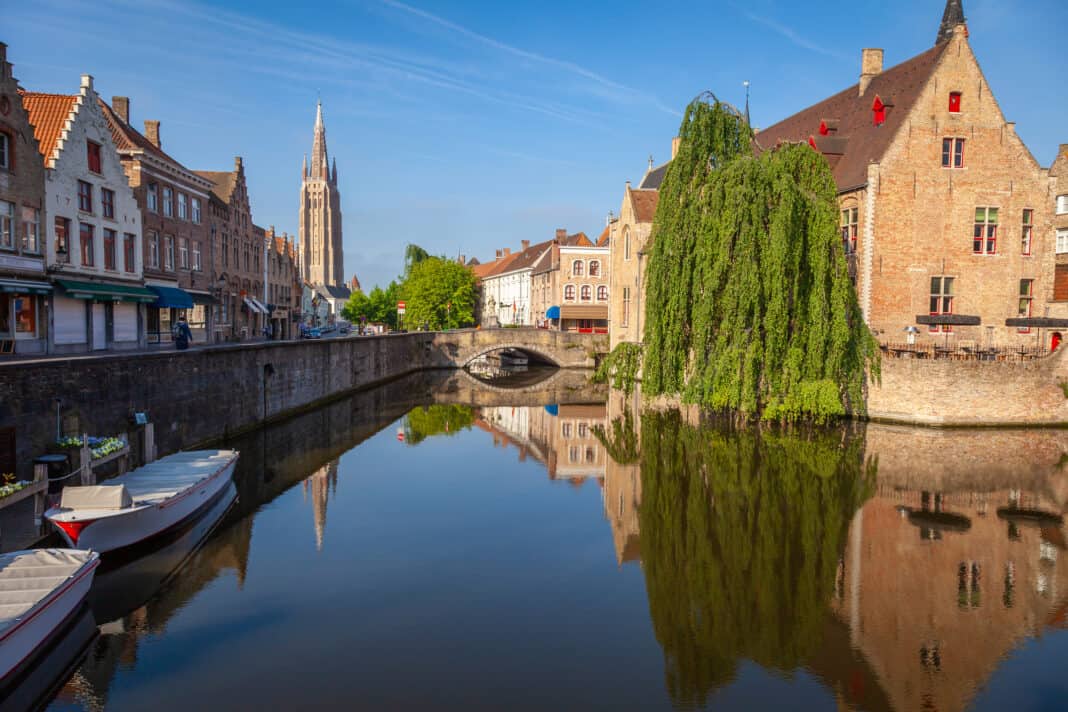
You’ll then be able to find the uniquely-shaped octagonal-lantern tower of Bruges’ iconic Belfort in the central square (Markt). This is right in the heart of Bruges’ historic centre.
I’ve told you that the walk should take about 20-25 minutes, but no doubt you’ll stop off a various points to take your phone out to take photos. So it may well take you longer!
How to get around Bruges
Aside from walking to and from the train station (you may decide to take the bus instead), most of your walking in Bruges is likely to be in the historic centre.
As Bruges is a relatively small city and the main attractions and sights are concentrated in close proximity to each other, it’s really easy to cover them in a few days or over a long weekend.
Unless you have planned out your itinerary before coming to Bruges, you might want to consider taking a canal cruise early on. This is also a good way to get around. The boat operators are really knowledgeable and will point out sights of interest that you can plan your walks around.
Alternatively, you can take a tour with a horse-drawn carriage. This gives you yet another unique perspective on this beautiful city.
From what I saw, they appear to pick up tourists in the main square (Markt), the adjacent Burg square (where you’ll find the City Hall) and Wijngaardplein, a charming square close to the Bejinhof. They really do offer a unique perspective of Bruges.
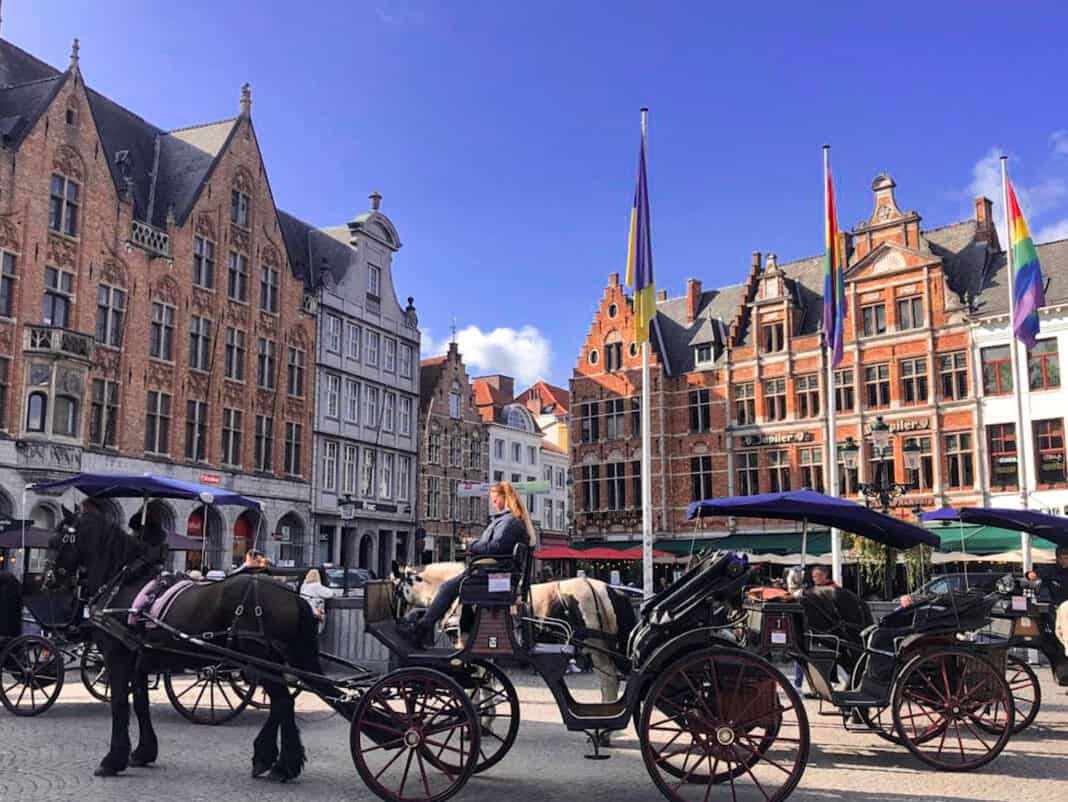
For a city that is largely pedestrian-friendly, you will also find numerous walking tours and this would also be another good option. Your guides will have a wealth of knowledge that often will be missing from guide books.
You can take a look at some of the walking tours on offer here.
You can also book trips that combine both a walking tour with a guide and a trip on the canal. This tour does just that: it combines a small group walking tour with a 40 minute canal boat trip.
The Musea Bruges Card
Considering Bruges’ size, the city is home to a diverse range of excellent museums. The breadth of subjects covered includes art, chocolate, beer, lace, lanterns, torture and even windmills!
With so much on offer, you might want to consider purchasing a 72-hour Musea Bruges Card for your weekend in Bruges.
The card gives you free entry to over 10 museums/monuments, including the Belfort and the City Hall (Stadhuis).
When I visited in October, it cost each me around 30 euros. I felt this was a reasonable price for what you get, and great value for money if you want to pop into several different places as part of your Bruges itinerary.
You can buy the Bruges Musea Card here.
My advice though would be to check in advance for the opening times of the different museums. On a weekend in Bruges you should be fine, but if you’re visiting during the week, note that some are closed on a Monday and some on a Wednesday.
Depending on how busy it is when you visit, it’s also advisable to book a time slot for climbing the Belfry: it can be busy and numbers are restricted. I was really lucky when I visited in early October. I went up the Belfry as soon as it opened at 9.30am and was the only person up there!
The best things to put on your itinerary for a perfect weekend in Bruges
Below I’ve outlined main attractions so you can choose how to plan your weekend in Bruges, taking into account your arrival and departure times and the weather.
Bruges’ historic centre covers a relatively small geographical area so you can easily plan your trip around specific sights and walk between them.
Just be mindful of whether a museum you want to visit is open that day (some are closed on Mondays and some on Wednesdays) and whether you need to book in advance.
In some cases, there may be a limit on entry numbers for safety reasons. For example, only limited numbers of visitors are allowed at a time up the Belfry.
I’ve listed below the main sights in terms of where they are located, as this may help you plan your visit most effectively. However, some of the attractions (e.g. museums) may not be of interest to you so this is really designed to be a guide that you can adapt to your own preferences.
The Grote Markt
Better known as Markt, Bruges’ large and spacious central square is located in the heart of the city’s old town. It’s probably the place to start on your first day.
The magnet for the crowds here is Bruges’ 13th century belfry tower. This measures 83 metres in height and can be seen from miles around. It’s one of the main landmarks to look out for if you want to get back to the historic centre.

The grand Provincial Court and the Historium Bruges museum stand on the square’s east side. The square is also framed by impressive medieval buildings with distinctive step-gabled roofs, many of which are now restaurants and bars.
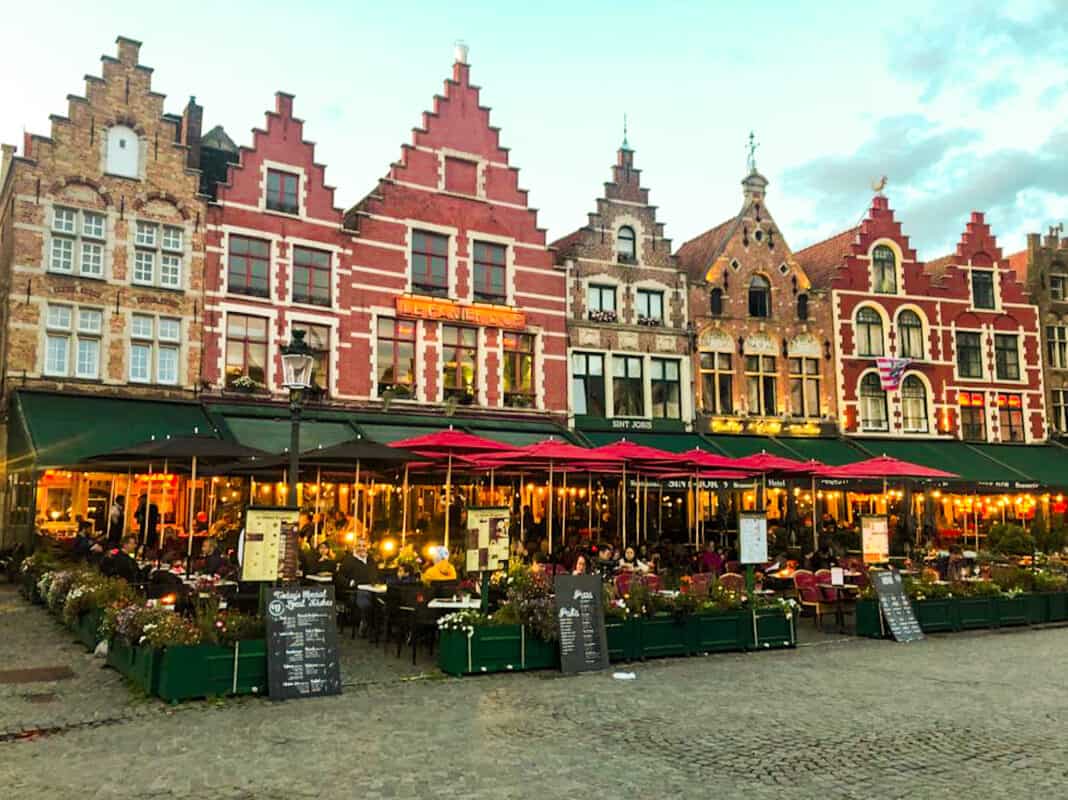
Towards the north end, there is a statute of local heroes Pieter De Coninck and Jan Breydel. This provides a focal point for people to sit under on sunny days. Both were leaders of the Bruges Matins, an uprising against the French in 1302.
In the Markt, you’ll also find horse-drawn carriages that you can pick up for tours of the city and a tourist information office.
If you’re visiting on a Wednesday, you’ll also be able to see the market, with stalls selling freshly baked bread, fish, meat, and fruit and veg, among many other things.
Markt is undoubtedly your starting point once you’ve made your way to the centre of Bruges. From here you can spend ages admiring the beauty of your surroundings, in particular the towering belfry.
Once you’ve done that, you should explore the surrounding area. Here you’ll discover lots of hidden gems, such as picturesque cobblestone streets and windy lanes, attractive squares and lots of superb architecture representing different styles.
Historium Bruges
If you’re in the Grote Markt, you may well want to consider visiting this historical museum located on the northeast side to learn more about the history of Bruges.
Described on its website as being Bruges’ most visited attraction, the Historium museum takes visitors back to the ‘Golden Age of Bruges’, walking you through seven historically-themed rooms. These cover information on Bruges Port, the city’s toll houses, the old medieval streets, and the bathhouse.
Highlights include a virtual flight along the medieval architecture and historical buildings in the Historium Virtual Reality. There’s also the opportunity to climb the 35 metre high neo-gothic Historium Tower. Here you can marvel at 360 degree views over the city centre, including an unrivalled one of the Belfry.
In the exhibition, you’ll also hear about the life of painter Jan van Eyck whose statue stands at the entrance to a former port area.
The square (named after the painter) in which his statue stands is worth visiting for the superb views it offers of the canal and the impressive gothic Burghers’ Lodge (Poortersloge) – now an art museum. It’s only a short walk from both Markt and Burg.
The Belfry of Bruges (Belfort)
One of the must-things to do in Bruges is to climb to the top of Belfry in Bruges, a medieval bell tower.

It forms part of a 13th century building with the structure comprising three segments. The bottom two square sections were made with brick during that same century.
However, the octagonal lantern tower at the top was built with Brabant limestone in the late 15th century.
Before you climb the small set of steps to enter the tower, it’s worth walking to the back of the huge courtyard behind it and taking photos of the Belfry as it towers over you.
Climbing the Belfry
Unlike the Belfry in Ghent, there is unfortunately no lift/elevator so you might want to think about this carefully before attempting the climb. It’s also a narrow staircase that is very tight to navigate (so much so that you are advised to leave your bag in a locker).
However, the view from the summit is extremely rewarding. And if you don’t like heights, it’s actually fine at the very top – you can’t get close enough to the edge to feel unsafe.
At the start of your climb there are some interesting artefacts, including two wrought iron doors. Behind them are sturdy padlocked chests, which at one time contained the city charters and where other important documents were held securely.
And then about a third of the way up, you reach a large room, which offers a great view down over the market square below. You then pass the Great Bell and the drum room before reaching the summit.
The views on a clear day in all directions are simply breathtaking.
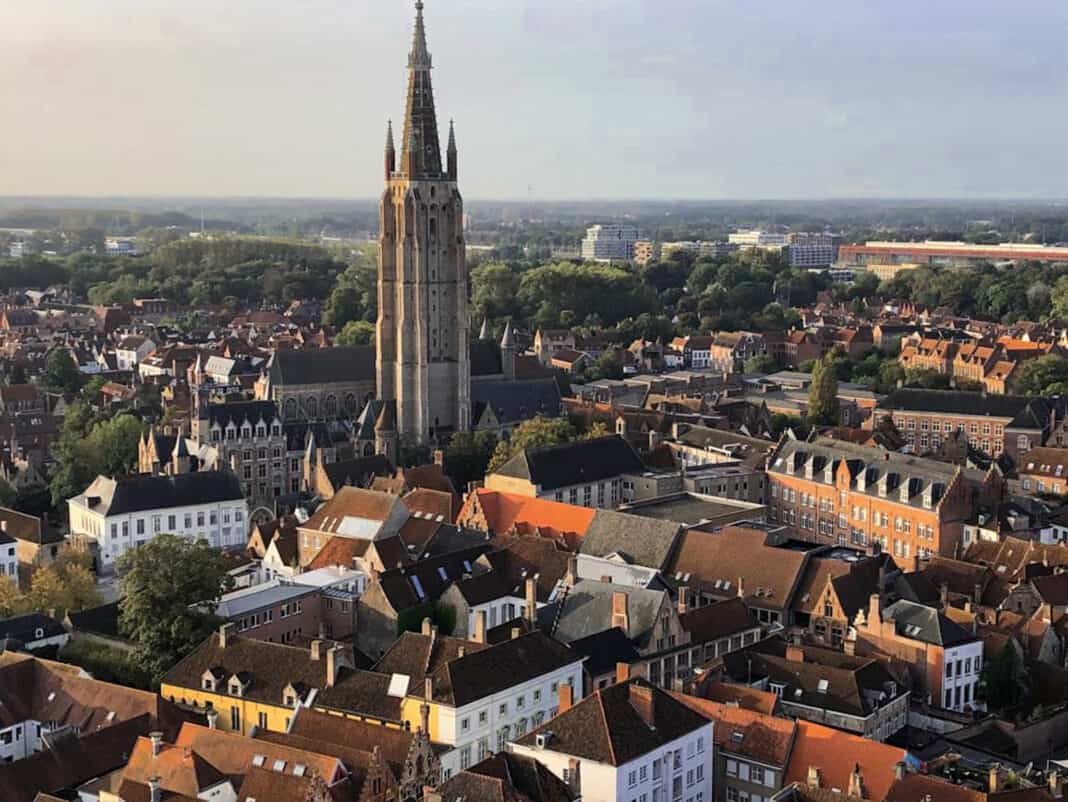
Inside you can also find out more about the carillon which consists of 47 bells – and that collectively weigh around 27 tons!
The information panels throughout the climb are really informative. They offer an array of fascinating facts so it’s worth stopping to read more about the Belfry’s history. For instance, you can find out how technology evolved over the centuries to improve the measurement of time and how important the use of bells was.
Burg Square
Literally a two-minute walk from the southeast end of Markt, you’ll find Bruges’ second most important square, Burg Square.
On the way down the connecting street (Breidelstraat), you’ll find the Bruges Beer Experience, as well as shops selling Belgian specialities such as waffles and chocolates.

Framed by a pretty tree-lined pedestrianised area on its northern fringe, Burg Square showcases three impressive buildings. These represent some of the finest architecture you’ll find in Bruges.
It’s also another area where you can pick up a horse-drawn carriage and is a great spot from which to take fabulous photos of the Belfry.
The City Hall, Palace of the Liberty of Bruges and Basilica of the Holy Blood
Historically, Burg Square has served as Bruges’ administrative centre and one of the most striking buildings you’ll find is the 14th century City Hall (Stadhuis). If you’ve read our post on Leuven, you’ll notice a remarkable similarity in the architectural style of both cities’ city halls.
While Bruges’ City Hall isn’t as impressive as Leuven’s, it is framed by two other architectural delights.
These are the 18th century Palace of the Liberty of Bruges, with its gold-adorned façade (and passageway down to the canal), and the Basilica of the Holy Blood, which contains a Romanesque chapel.
The intricacy of the designs on all three buildings is incredible.
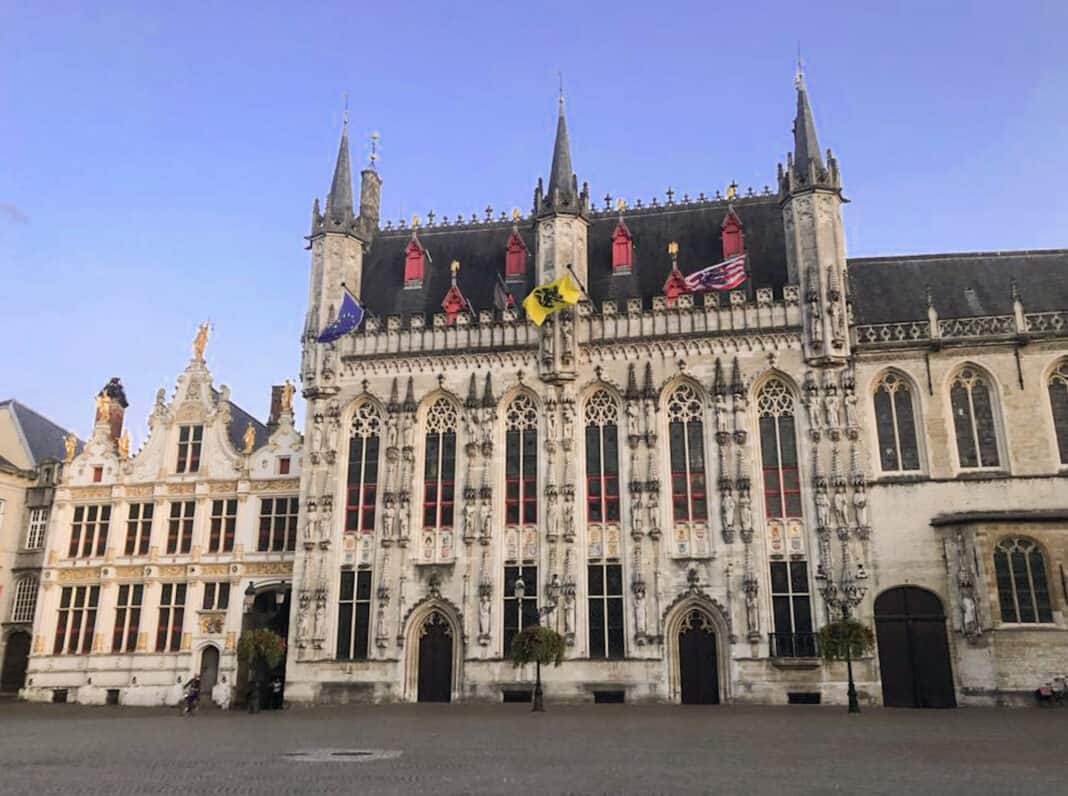

The City Hall (Stadhuis)
Of the three buildings in Burg Square, I only had time on my weekend in Bruges to pop into the City Hall (also referred to as the Town Hall).
On the ground floor you’ll find a cavernous room with an attractive black and white square tiled floor and pillars. There’s a small side annex with portrait paintings hanging from the wall depicting the city’s rulers. You can go in and see this without a pass or ticket.
However, if you’ve purchased the 72-hour Musea Bruges Card, you can also visit the stunning gothic hall (Gotische Zaal) upstairs. This has exceptional murals and a beautifully-coloured hanging vault.
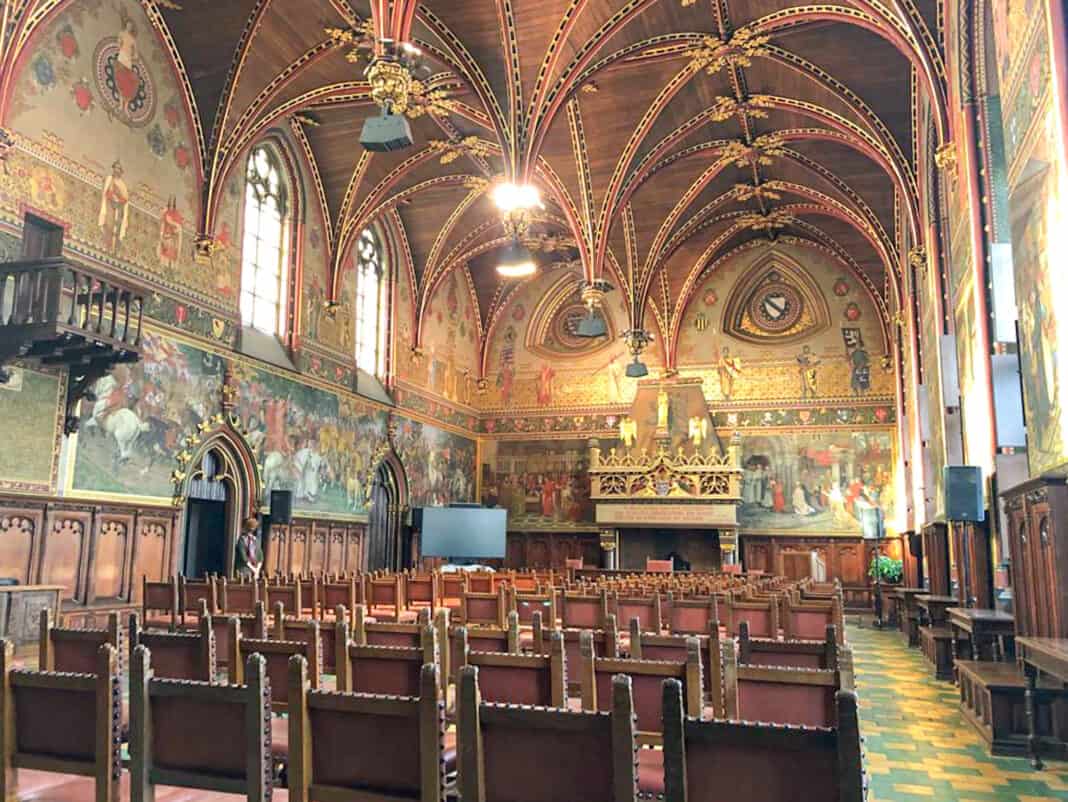
When you enter, you are given an information sheet. This explains how the upper floor of the City Hall was divided into two areas: a vestibule and the chamber of aldermen. These were rejoined in 1880s into a single reception hall.
It also provides more information about the history of the murals, which were designed by painter Albrecht De Vriendt (apparently it took nine years to start the work though due to the approvals that were needed for it).
And one of the most interesting things I discovered was that the Flemish ‘cire fondue’ technique, which is based on wax, was applied to create the murals rather than the Italian fresco style.
In an adjacent room, you’ll find the Historic Hall. Here you can learn about Bruges’ longstanding relationship with the sea and the canal networks that linked the city to the coast.
You can get information on this via the headphones that you can pick up on the right-hand side. They have three colours representing Dutch, English and French translations.
Rosary Quay
If you walk through the short passageway under the Palace of the Liberty of Bruges, you’ll come to the canal and one of the boat stops to pick up a tour.
To your left you’ll see the old fish market (Vismarkt) and if you walk to the right past the booth selling tickets for the canal boat tours, you’ll enter the pretty Huidenvettersplein. This small picturesque square is lined with restaurants and beautiful period buildings. It really comes alive at night.
As you step outside the opposite corner of this square, you’ll come to what is said to be the most photographed spot in Bruges, the Rosary Quay.

During the day and especially at night, when the lights come on, you’ll find tourists standing here snapping away. The panoramic view is exquisite.
Sweeping from left to right, you’ll see the spire of the Church of Our Lady as well as the Belfry’s tower. This is particularly beautiful when it is floodlit at night. You’ll also see the canal snaking its way through the centre.

A canal boat trip
Look at a map of Bruges and the whole city appears to be almost entirely surrounded by a wide body of water. This illustrates the importance of the canal network to Bruges’ prosperity over the centuries.
In the historic heart of the city, you’ll find quite a few interconnected and picturesque canals running alongside or close to many of the main attractions.
Although not all of these canals are accessible to the public through boat cruises, you can certainly explore a good stretch of the central canal network on a tour.

You can also book combined boat and walking tours.
However, when I went in October 2023, I paid 12 euros for a canal boat tour by just turning up and paying at one of the booths at the boat pick up points. This was a 30-minute trip and makes it a quicker and more affordable option than booking a tour if you’re on any sort of budget.
I would thoroughly recommend taking a canal boat trip while you’re on a weekend in Bruges. It’s a great way to see some of the main sights. The boat operators are very knowledgeable and, importantly, you get an unrivalled view of the city and a different perspective on it.
You can pick up boats at quite a few spots, including at the Rosary Quay and near the fish market (Vismarkt).
Sights to see on a canal boat tour
I picked up a boat ride near the fish market and really enjoyed the cruise. In one direction, the boat operator pointed out the beautiful Meestraat Bridge, and the city’s former port area.
At the port you can see the statue of painter Jan van Eyck and the Burghers’ Lodge (Poortersloge) behind it. There’s also the charming Godhuis de Pelikaan (old alms houses) on Groenerei which have apparently featured in a Bollywood film.
After returning past the starting point and navigating through Rosary Quay, we were afforded great views of the Church of Our Lady at various points. You pass under the Bonifacius Bridge and get an excellent perspective of the Museum Sint-Janshospitaal’s architecture.
You then have to duck to keep your head under Bruges’ lowest bridge and go onto the Begijnhof where the boat turns back.
Dijver and the lace map
When you are standing at Rosary Quay, if you wander in the direction of the Church of Our Lady with the canal on your right, you’ll enter a really picturesque stretch called Dijver. Here you’ll find a large map of the city made from lace just before you come to a bridge over the canal.
Together with Venice, Bruges is referred to as being the ‘cradle of lace’. By the mid-16th century the city became a really significant place for its production (if the history of lace in the city interests you, you might want to visit the Lace Centre and Museum).
Just before you reach the lace map, you can’t miss a large blue door on the left-hand side of the road. This marks the entrance to one of Bruges’ most superlative museums – the Groeninge Museum.
The Groeninge Museum
The superb collection housed in the museum isn’t huge but the breadth of works spanning centuries of artwork is quite astonishing. This is undoubtedly one of the top cultural highlights in Bruges and I was able to use the 72-hour Musea Bruges card to gain entry.
The collection highlights the important role played by the main founders of the Flemish Primitives art movement in the 15th century – Jan van Eyck, Robert Campin, and Rogier van der Weyden.
Notable pieces of work inside include Gerald David’s Judgment of Cambyses and Anthony van Dyck’s Samson and Delilah. You will also find some more contemporary pieces by artists like Paul Delvaux and Rene Magritte.
The Gruuthusemuseum
A short walk on from Groeningemuseum’s blue door, literally as you cross the bridge, you’ll find the entrance to Gruuthusemuseum on your left. You immediately walk into an impressive courtyard, with the spire of the Church of Our Lady towering up in front of you.
The building next to the church to the left is the Gruuthusemuseum. This is worth popping into. Although it is not the easiest museum to navigate, it does contain some fascinating artefacts.
This former 15th century palace once belonged to wealthy nobleman Louis de Gruuthuse, hence the name of the museum. Apparently, he was an advisor to three Burgundian dukes and held great power and influence.
One of the information panels also inside said that he had the second largest library in the Burgundian Netherlands which includes 150 manuscripts. Apparently his personal motto was ‘Be the best you can be’.
One of the most interesting things you’ll find here – at least for me – is upstairs in a room that provides access to the family’s private chapel. At first glance, this restored oratory doesn’t appear that remarkable.
However, when you walk over to the glass windows at the far end, you can look down at where the choir sits in the Church of Our Lady. Apparently, this was all possible because Louis had his palace and the church connected by a two-storey prayer chapel.
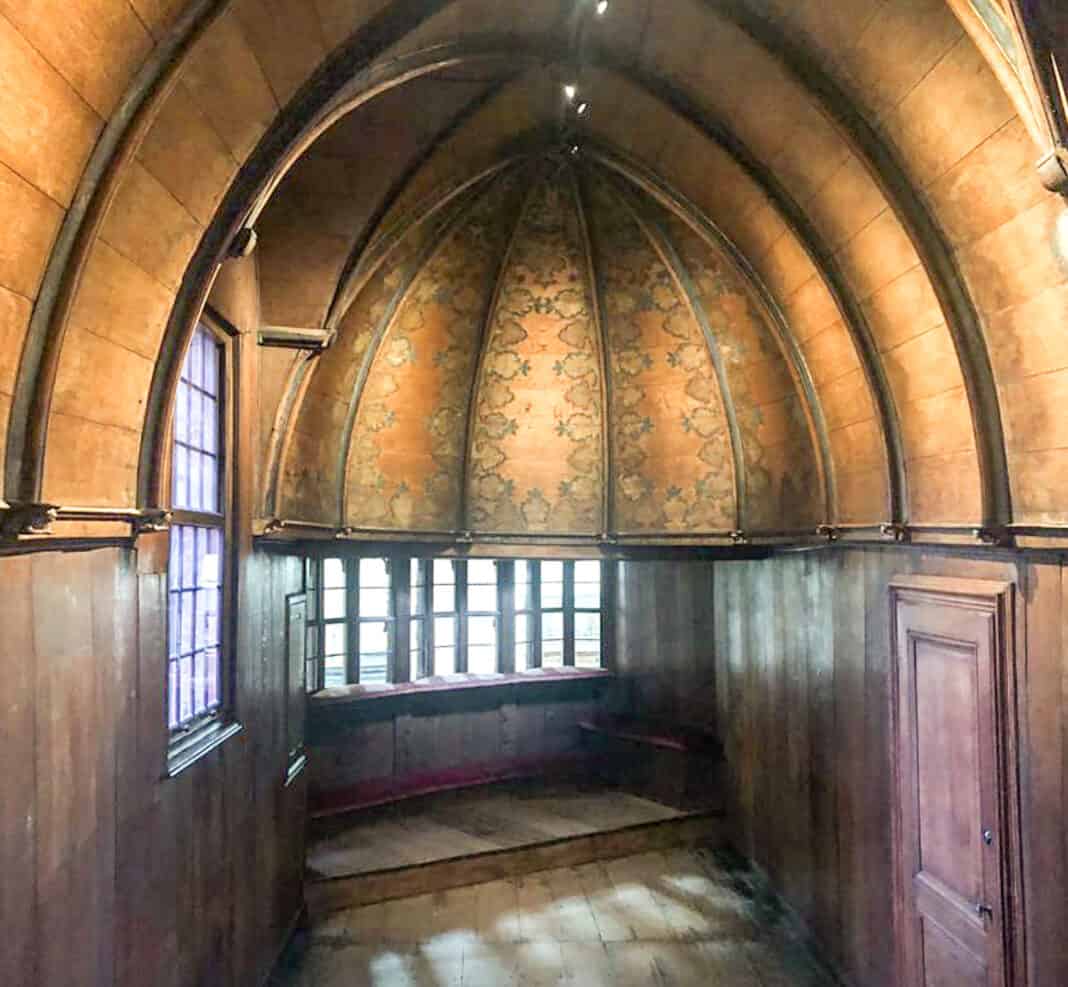
This meant that he and his wife could sit in the upper chapel and observe Mass without having to leave their palace. In the connecting church, a panel explains how a priest could access the upper chapel via a staircase.
The Church of Our Lady
Your curiosity may already have been piqued after looking through the oratory windows down into the Church of Our Lady. If so, you should definitely visit this amazing building (known also as Onze-Lieve-Vrouwekerk).
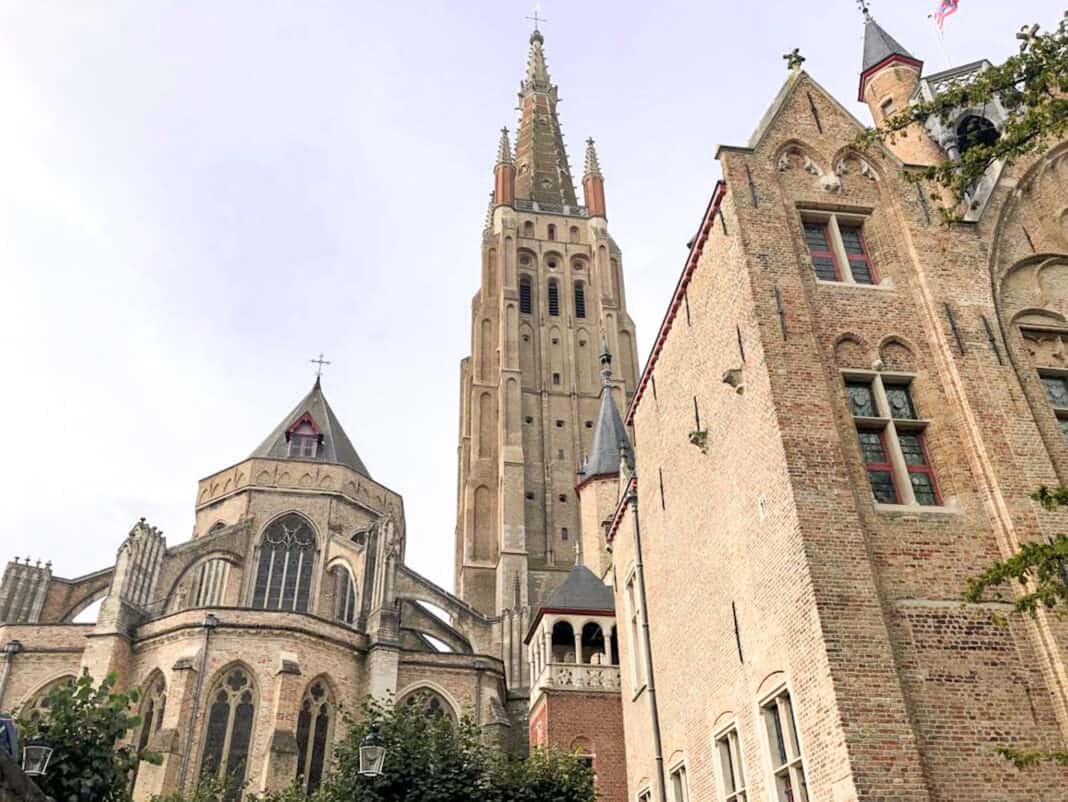
Dating from the 13th century, this religious landmark is one of the first things you spot on Bruges’ skyline when you approach the city, thanks to its soaring 115 metre spire, the tallest building in the city.
Aside from its spectacular interior, the church also contains at least one very significant artwork which you will have to pay to view – this is Michelangelo’s Madonna with Child sculpture. Adults have to pay eight euros to enter the church’s museum unless you have the 72-hour Musea Bruges card.
Rather confusingly, there are two Madonna and child statues inside this paid section. The first you’ll come across is attributed to Pieter Pepers and dates from 1763. However, the main attraction is the smaller one by Michelangelo, which was donated to the church in 1514.
This marble statue, measuring only 1.28 metre in height, is apparently the first of only a few works by the famous artist to leave Italy during his lifetime.
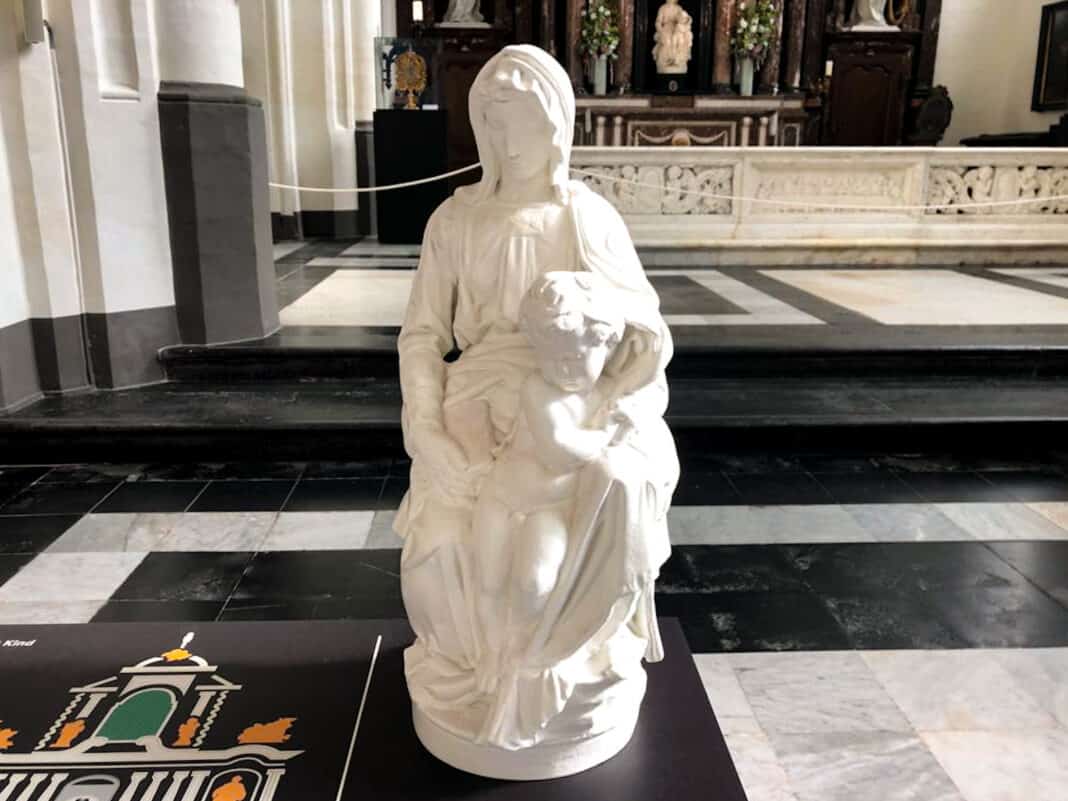
So prized was Michelangelo’s artwork that according to the information panel next to it, the statue was looted twice!
In the paid section, you can also see an ensemble of beautifully designed confessionals dating from the 1690s, as well as the other side of the oratory windows in the adjacent Gruuthusemuseum.
There are some beautiful stained glass windows and two impressive tombs. One of the tombs is of Charles the Bold, the Duke of Burgundy, who ruled the Low Countries. The other is of his daughter Mary of Burgundy who assumed this role after he died.
Boniface Bridge
Another sight you may wish to see is the extremely popular tourist attraction Boniface Bridge, a small stone pedestrian bridge. Surprisingly, considering the age of the buildings around it, this dates from the early 20th century.

It wasn’t entirely clear to me why the bridge is so popular when I visited, given how many lovely bridges there are in the city. But it is next to the Church of Our Lady with its wonderful gothic architecture.
It may also be because some websites label this as Lovers’ Bridge, one of the most romantic bridges in the city.
My understanding, however, is that this is not correct. Romantic it may be, but Lovers’ Bridge is actually the bridge that straddles Minnewater Lake which is further on and near the bejinhof (see below).
Finding Boniface Bridge
There are several ways to find Boniface Bridge. One way is via the back of the Groeningemuseum and the attractive Hof Arents park with its distinctive sculptures. Alternatively, you can start in the courtyard outside the Gruuthusemuseum and walk down the pathway at the side under the archway.
Another option is to turn left outside of the Church of Our Lady and walk down Mariastraat and then take a left. This pathway takes you round the back of the church and gives you magnificent views of the landmark’s side profile.
Right next to the bridge, there’s a statute of Spanish scholar and Renaissance humanist Juan Luis Vives.
You’ll also get to see the bridge if you take a boat cruise on the canal. This will take you under the bridge and give you a unique perspective on it. You’ll also get to hear some fascinating facts: I discovered for example, that you if you look up at the back of the Gruuthusemuseum, you can see the smallest window in Bruges, a really tiny one made of stained glass.
The important thing to remember if you’re going to the Boniface Bridge and want to take photos, is to get there early morning or early evening. This will help you avoid the inevitable stampede of tourists.
The Begijnhof
Two more of Bruges’ attractions that are worth seeing are located very close to each other – the Begijnhof (Beguinage in French) and Minnewater (the Lake of Love).
To get here, you need to turn left outside the Church of Our Lady and continue down Mariastraat. After a short distance, you’ll see a turning to the right called Walstraat that leads you into an attractive square lined with restaurants called Walplein.
Here you’ll find a brewery (Brouwerij De Halve Maan) where you can do tastings.
If you then walk a short distance past the brewery into the street at the end of the square and turn right, you will enter a really scenic part of the city known as Wijngaardplein.
This spot is another place where you can pick up horse-drawn carriages. It also has some excellent looking restaurants. If you look to the right, you’ll see a bridge that spans the canal.
Walk over this bridge and under an impressive archway dated 1776, and you’ll enter a beautiful oasis. This is Bruges’ 13th century Begijnhof (the Princely Beguinage Ten Wijngaarde).
Added to the UNESCO World Heritage list in 1998 and laid out around a wooded green, the Begijnhof comprises rows of beautiful white-washed houses. It is also home to a church and a small museum.
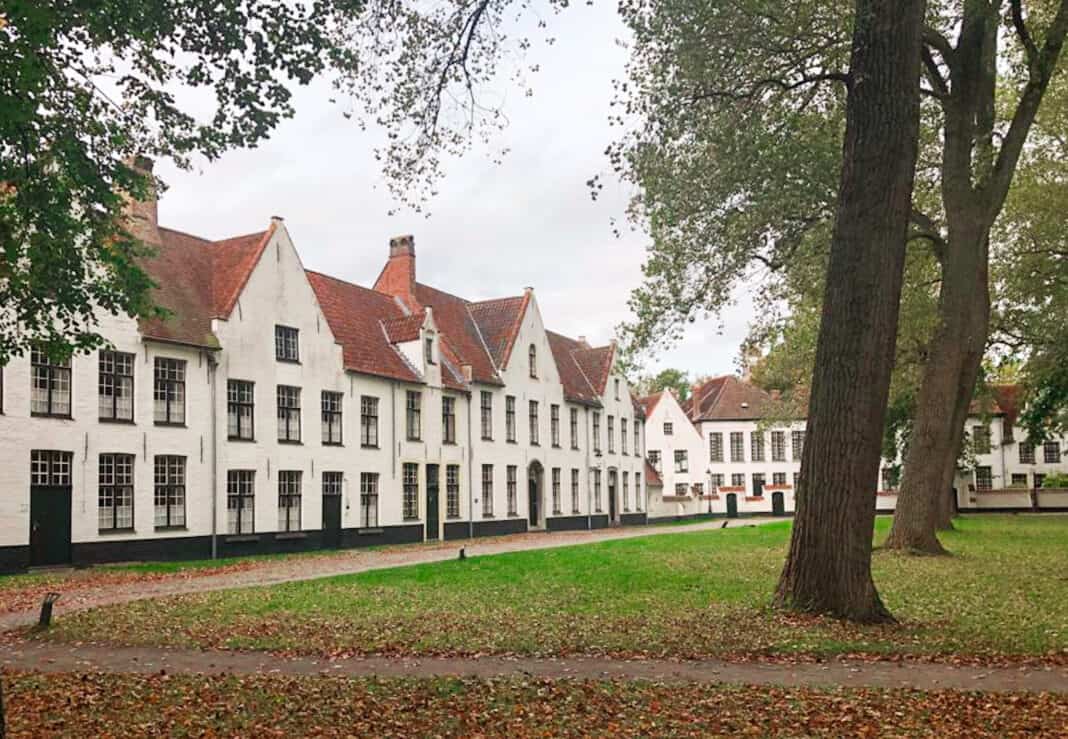
It’s definitely worth spending some time wandering around this tranquil environment. If you’ve read our blog on Leuven and Mechelen, you’ll know that Begijnhofs were home to beguines – lay religious women who ran the Begijnhofs as self-sufficient communities.
The Lake of Love (Minnewater) and Lovers’ Bridge
When you come back out on to the bridge by the entrance to the Begijnhof and immediately look to your right, you’ll see a body of water with parts that have swans and ducks on it.
This is the turning point for the canal boat cruises which can’t progress any further. However it connects on to a wider lake at the back known as Minnewater (the Lake of Love).

Minnewater is a large lake that features a lock house at one end. It’s regarded as one of Bruges’ romantic places and is connected onto Lovers’ Bridge.
You can wander around the lake and walk over the bridge into the adjacent Minnewater Park. This is the bridge that is actually Lovers’ Bridge. Local legend says that if you cross it with your loved one you’ll have everlasting love together.

If you fancy it, you can grab something to eat and drink at the gothic style castle/come brewery restaurant called Kasteel Minnewater that overlooks the lake.
Try some Belgian beer
Belgium is famous for its beers and there are literally hundreds to choose from. In Bruges, you can try out locally brewed classics as well as popular brands from other regions.

Be aware, however, that the alcohol content can be very high. So it’s advisable that you pace yourself and maybe try them with a meal!
Breweries
If you have time and fancy it, there are quite a few brewery tours in Bruges that you may want to consider.
- Top of the list is De Halve Maan brewery, located in Walplein, which dates back to the mid-19th century. You can take a guided tour of this family brewery and enjoy a tasting as part of your visit. However, there is also a brewery café on the site: you can simply turn up and try out some of the beers brewed such as Brugse Zot and Straffe Hendrik.
- Another one that you may want to consider is the Bourgogne des Flandres Museum. Located a stone’s throw from the Rosary Quay and overlooking the canal, you can discover how the Flemish beer of the same name is made, together with its two variations, Blonden Os (Blond Ale) and Bruinen Os (Brown Ale).
Beer shops
If you are looking for beer shops, there are a couple worth visiting while you are here.
- On Wollestraat, near the Rosary Quay, you’ll find 2be Beer Wall. This features a long wall displaying an enormous range of different beers. The bar/café inside is located on the canal side and offers views from the terrace. There is also a shop.
- If you walk up the same road with the Torture Museum on your right (in the direction of Markt and the Belfry), you’ll come across a superb beer outlet called The Bottle Shop. Here you can buy beers to take home from a massive range of local and regional brands.
The Beer Experience Museum
Another place you may fancy visiting is the Beer Experience Museum. This is located a two-minute walk from the Belfry on Breidelstraat, the short street that connects Markt with Burg.
Inside the museum you can learn about different beers, the brewing process, and what food to pair it with, among many other things. There is also a bar and a shop.
Bars
You may also fancy visiting some unique bars that offer a wide selection of Belgian beers.
These include:
- Cafe Cambrinus
- the cellar-based Le Trappiste
- Trappist beer specialist bar Rose Red
- the charming Cafe Vlissinghe
- the legendary café Brugs Beertje
If you are planning to visit, be aware that some are not open every day, so check in advance.
Try some Belgian chocolate
Apart from buying a Belgian waffle with chocolate from one of the many food outlets dotted around Bruges, a visit to the city would not be complete without tasting some delicious Belgian chocolate.
You can try your hand at making some chocolates in a short workshop.
Or you could stop by some of the chocolatiers in the city. There are lots to choose from and some of the chocolates in the shop windows are quite impressive in their design.
Here are a few of the best that you might want to consider visiting:
- The first is Chocolatier Dumon, an artisan outlet with branches in other Belgian cities. It is located at three different addresses in Bruges. If you visit the website you can do a virtual tour and also see in advance what chocolates they make.
- Another is the family-run Old Chocolate House, which has been operating since 1997. Located on Mariastraat, the shop is set out on two floors. On the ground floor, you’ll find a shop that sells ‘chocolate in all its forms and various tastes’. On the first floor, the owners have created ‘Chocolate Heaven’, a tea-room where visitors have a choice of more than 30 different types of hot chocolate, coffee and tea, plus home-made waffles and sweets.
- Alternatively, you might want to consider visiting a museum that is dedicated entirely to chocolate. If so, head to the appropriately named Choco Story Chocolate Museum, which is located on Sint-Janssraat. Open every day from 10am until 5pm (last entry 4 pm), inside you will learn about the history of Belgian cocoa and chocolate.
You’ll also find a great selection of chocolates available at the supermarkets in the historic centre for a fraction of the price advertised in the speciality shops.
Bruges’ windmills
Visitors to Bruges may want to see some old windmills that are located on the city’s eastern fringes. In the 13th century windmills were a common sight around the city walls and provided flour for local residents.
Only four remain, however, and form a line alongside the Ringvaart (the wide canal that forms an eastern border with the historic centre).

Of these, two are open to the public and contain small museums.
The nearest windmill of the four is a short walk from one of the city’s old gates (Kruispoort) and is worth walking to, to take pictures. I did just that and found you also get great views of Bruges’ skyline from its base on a large mound.
However, if you do want to visit one of the museums, you’ll need to add on a bit of extra time to walk a little bit further to St-Janshuismolen (the only one still milling grain) and Koeleweimolen.
Day trip to Brussels
You’re probably going to want to just focus on the above sights on a weekend in Bruges. However if you have more time, or fancy a day trip, then you could spend the day in the capital, Brussels.
As you would imagine, there’s lots to do here. There’s the elegant Grand Place (Grote Markt) with the Hotel de Ville and La Maison du Roi. These are not to be missed: the Hotel de Ville in particular, with its stunning tower standing nearly 100 metres high.
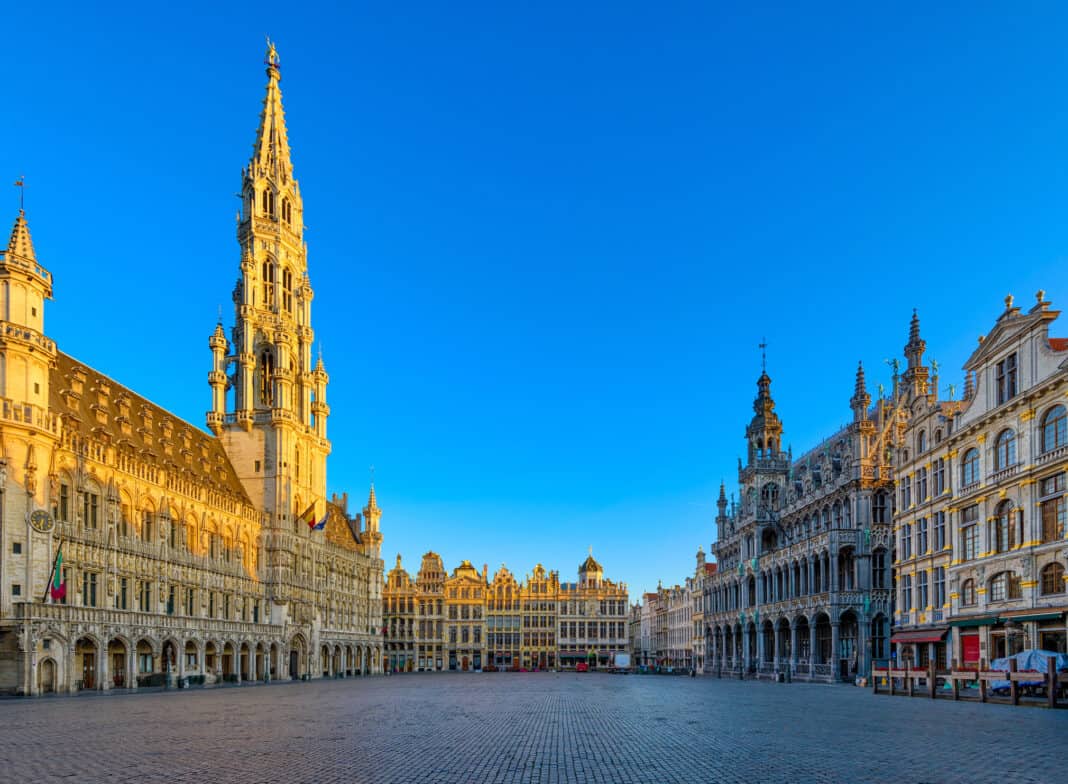
There’s also the Galeries Royales Saint-Hubert, an eye-catching collection of three 19th-century glass arcades (reportedly one of Europe’s oldest shopping arcades).
For something a bit more unique, wander up to see the Mannekin-Pis, a small bronze statue of a boy whose act of urination creates a fountain (a popular place for tourists to take a look!). Other sights include the Mont des Arts garden, the Royal Palace of Brussels and several art museums.
These are just a few of things you can see on a day out in Brussels. There are also other sights a bit further out, so if you want to make the most of your time, I’d recommend considering using the hop-on hop-off bus which will help take you between the different areas and maximise your time.
You can also read about things to do in one day in Brussels here.
The best time to visit Bruges and see the main sights
Ideally, the best time for a weekend in Bruges is when it is dry and warm enough to take a canal boat cruise or a ride on a horse-drawn carriage. The city is particularly charming when it is bright and sunny.
However, this is also likely to be when most tourists visit at the height of the season.
As many tourists come to Bruges on a day-trip, one option is to get up early and explore the city and its sights before the crowds descend on the centre.
This is especially the case in relation to some of the attractions, notably St Boniface Bridge, where large tour groups can end up spoiling your views and/or photos.
Planning out your visit to Bruges will also be dependent to a certain extent on what the weather is like. For example, if you are likely to get only one decent day, it would be advisable to make sure you do a canal boat cruise on that day.
Typically, boat cruises are open to the elements, so spring through to early autumn is the ideal time. As I mentioned earlier, the boat operator will point out places of interest along the way that you may want to return to later.
Also, you will get some great photos from being on the water than you won’t get walking around.
However, if you find it is raining and a boat cruise is not an option, Bruges still has some first-class museums as well as other places of interest where you can shelter from the wet and/or cold.
You really will be spoilt for things to do, no matter what weather conditions you face on your weekend in Bruges.
A weekend in Bruges
I hope you have a great time in this historic city, especially if this is your first time here, and that the list above covering the top things to do on a weekend in Bruges is helpful.
Bruges is one of the best places to visit for a weekend in Belgium. However, there are also other fabulous places that are not far away. I therefore have other posts that you might be interested in:
For ideas for other European short breaks or day trips, check out some of the other posts on my website.
Written by Nick Warburton with Emma Marshall


